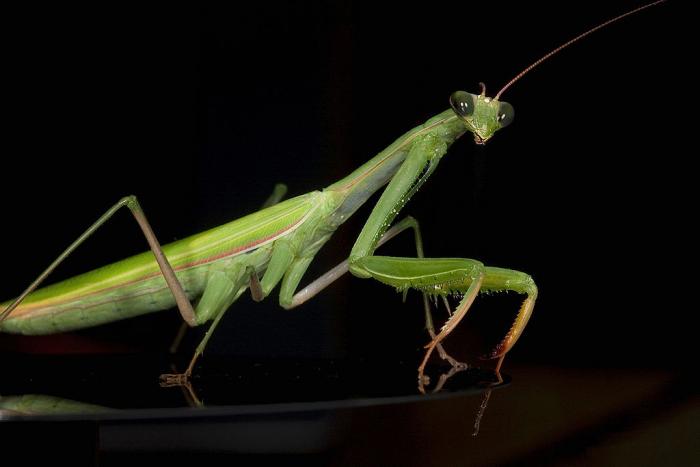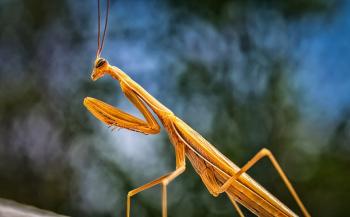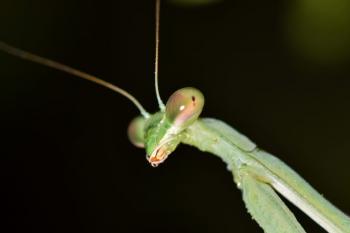
A praying mantis is a large insect that gets its name from its very long front longs that they hold in a position that resembles praying. Mantises are in the order Mantodea. The Latin name of the praying mantis is Mantis religiosa. What do you think that means?
Both males and females have long bodies with two pairs of wings. Mantises have a mobile, triangular head with large compound eyes. Their front legs, also called the raptorial legs (what do you think this means?), are efficient for the capturing and restraining fast-moving and/or flying prey.
Female praying mantises are larger and heavier than the males. Males have larger eyes and antennae. Praying Mantises have front facing eyes which is unusual for insects. Mantises also have a compound multi-lensed eye structure at the front of their head called ocelli. The ocelli are more pronounced in males. Using this information, do you think you'd be able to tell the difference between male and female praying mantises?
Since males are smaller than females, they are more agile. Females, on the other hand, are more powerful. Adult females are so large and heavy that most of them cannot fly! Their wings cannot carry their bulky weight.
M. religiosa can be found around the world in many different colors including yellow, brown, green, and sometimes black. Scientists have not discovered a reason for this color variation but it seems that the colors match their habitats. Green mantises will be found near green grass and spring trees while brown ones would be attracted to brown grass and dead leaves. Seems like they are good at camouflaging! If they have to leave their location and their coloration no longer matches their surrounding, they will likely be killed by birds or other small animals that eat insects.
Mantises lay their eggs in an egg case that looks a lot like a miniature wasp hive. They can usually be found attached to trees, branches, or stumps. When they hatch, nearly 200 tiny mantises emerge!
The Euclid Public Library had a mantis egg case on display in the children's area in 2019. Did you get a chance to take a look?


- Juvenile mantises always emerge from the egg case in the morning!
- Females often need more time to develop so they moult. This means they cast off part of their body in order to grow bigger. This is likely why they live longer and are bigger than males.
- After mating, females often eat the male. This provides her with nutrients so she doesn't have to hunt. She gets more nutrients from eating the male than she would from hunting. Remember, she can't fly!
- In Germany, praying mantises are endangered species. It is illegal to kill or keep one as a pet.
Praying Mantis by Tamra B. Orr (ebook accessible using Hoopla)
My Awesome Summer, by P. Mantis by Paul Meisel
